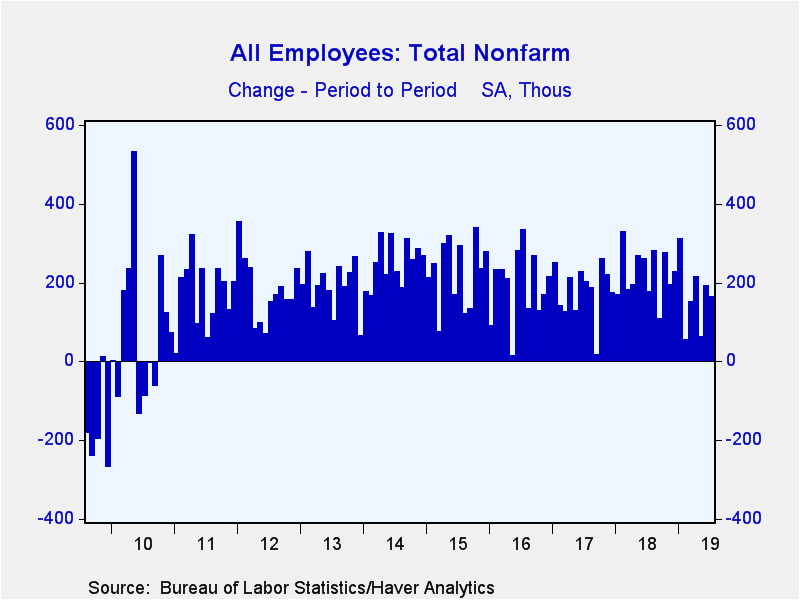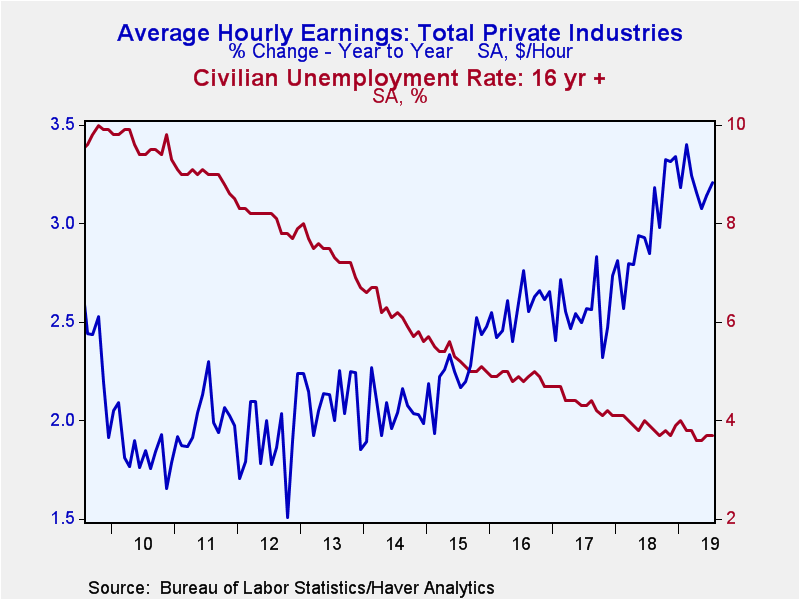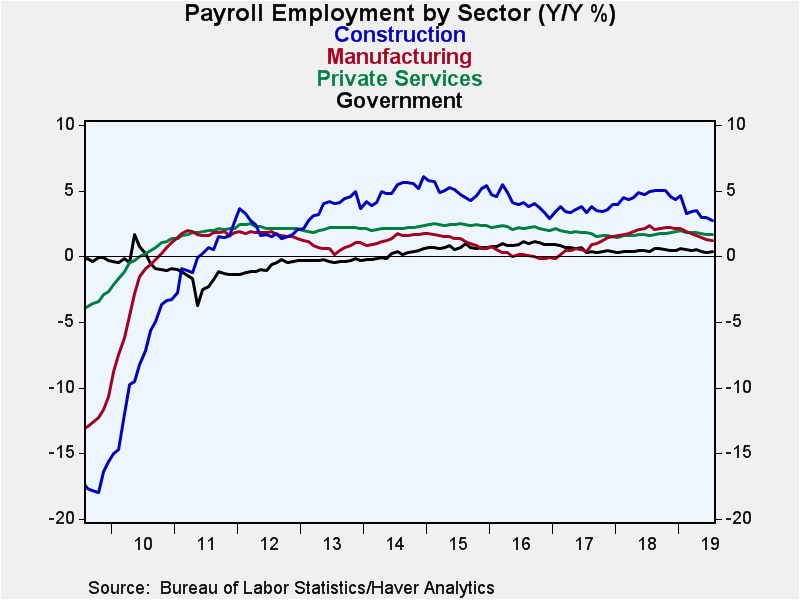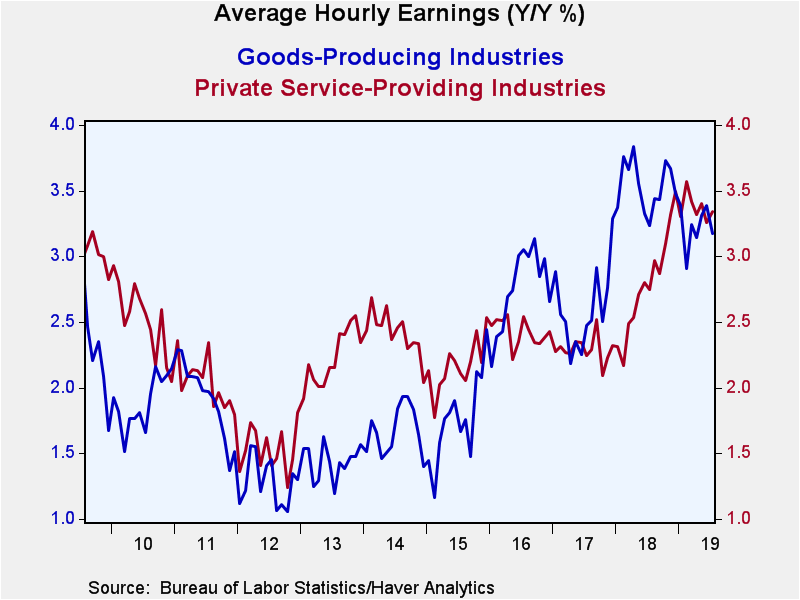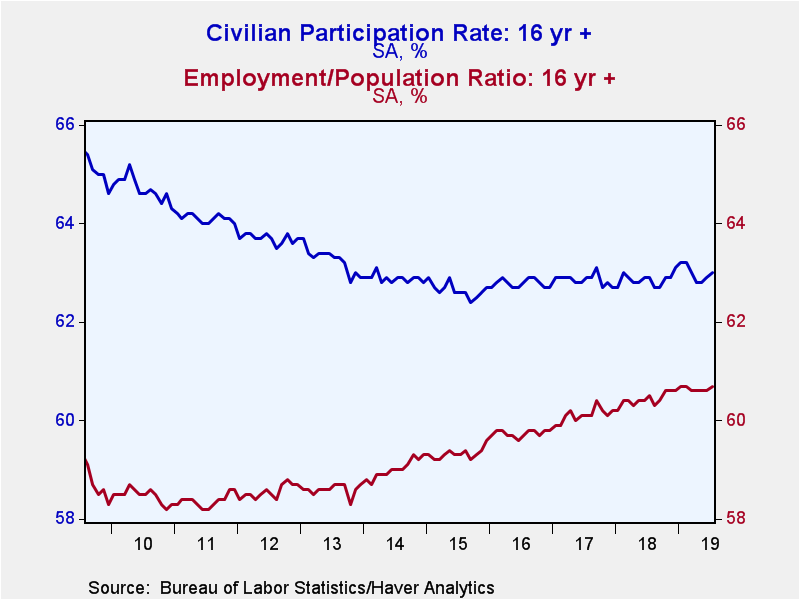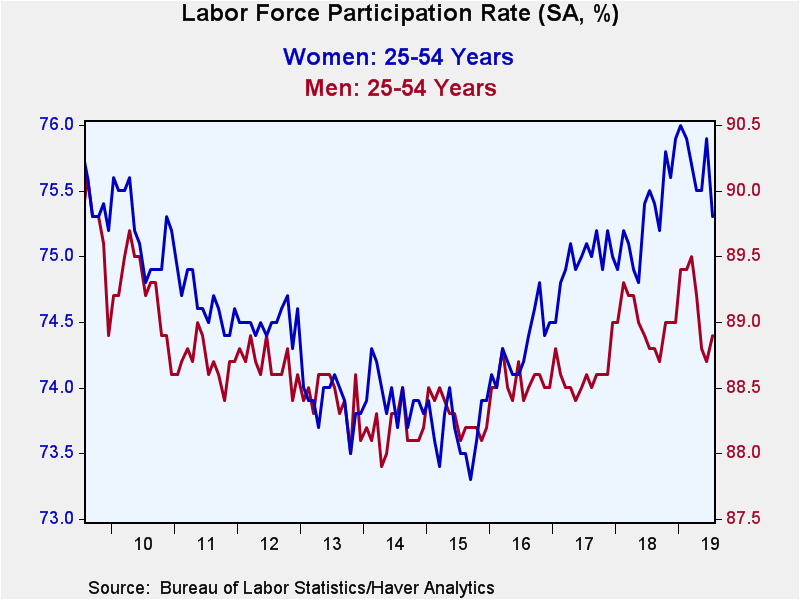 Global| Aug 02 2019
Global| Aug 02 2019U.S. Payroll Gain Moderates; Earnings Increase & Jobless Rate Steadies
by:Tom Moeller
|in:Economy in Brief
Summary
Job growth eased during July. Nonfarm payrolls increased 164,000 (1.5% y/y) last month following a 193,000 June rise, revised from 224,000. May's increase also was revised lower to 62,000 from 72,000. So far this year, payrolls have [...]
Job growth eased during July. Nonfarm payrolls increased 164,000 (1.5% y/y) last month following a 193,000 June rise, revised from 224,000. May's increase also was revised lower to 62,000 from 72,000. So far this year, payrolls have risen an average 165,000 per month after a 223,000 monthly average last year. July's rise in payrolls roughly matched expectations for a 168,000 gain in the Action Economics Forecast Survey. Average hourly earnings in the private sector increased 0.3% for the third straight month. A 0.2% increase had been expected. Growth during the last twelve months of 3.2% was below the recent peak of 3.4% logged in February.
The unemployment rate held steady at an expected 3.7%. Employment in the household survey rose 283,000 and the labor force increased 370,000. The overall jobless rate, including those who were marginally attached or working part-time for economic reasons, slipped to 7.0% last month from 7.2% in June. The figure was near the record low of 6.8% reached in October 2000.
From the payroll employment survey, the monthly increase in jobs lessened the y/y change to 1.5%, down from its peak of 2.3% in February 2015. Factory sector payrolls improved 16,000 last month and since early this year, monthly gains have picked up. Yearly growth of 1.2%, however, still remains below the recent peak of 2.3%. Construction sector employment growth has eased considerably to 2.7% from 5.1% this past January. Mining sector payrolls declined 5,100, off for the second consecutive month with y/y growth of 2.6% sharply below the 10.1% peak last October.
In the private service sector, the 133,000 rise in July payrolls left the 1.7% y/y gain well below the 2015 peak of 2.4%. Information sector payrolls declined 10,000 last month, and they fell 0.5% y/y. The number of retail trade jobs declined 3,600 and 2.0% y/y. The number of education & health services jobs increased a firmer 66,000. Growth y/y picked up recently to 2.6%, but remained below late-2015 growth of 3.0%. Professional & business services jobs improved 38,000 for a second straight month. That was not enough to keep the y/y change from falling to 2.2% from its late 2014 peak of 3.4%. The number of financial activities jobs rose 18,000, and 1.2% y/y growth was half the early 2017 peak. Leisure & hospitality payrolls increased 10,000 last month. The 2.2% y/y improvement was down from the mid-2013 strengthening of 3.9%, but recently has risen moderately.
Government sector payrolls improved a steady 16,000 (0.4% y/y). The increase owed to a 14,000 rise in local government which grew a steady 0.7% y/y. Federal government employment grew 2,000 and y/y growth of 0.9% compared to declines in 2017 and 2018. The number of state government jobs held steady, but they declined 0.6% y/y after a 1.6% peak rate of growth in mid-2017.
The third monthly 0.3% rise in private sector average hourly pay left the 3.2% y/y gain below the recent peak, but still up from 2.0% in 2014. Factory sector earnings nudged 0.1% higher. The 2.5% y/y rise was improved from 1.3% y/y gain in the middle of last year. It remained below the 3.3% advance in early in 2016. Construction sector grew a lessened 2.8% y/y. Information sector pay strengthened 1.4% last month and y/y growth surged to 6.5%. Earnings in the financial and in the leisure & hospitality sectors firmed 3.7% y/y. Professional & business services earnings grew 3.1% y/y, more than double the 2012 low. Showing no improvement were earnings in the education & health care sectors where earnings rose 1.7% y/y, down from 2.7% growth during all of last year.
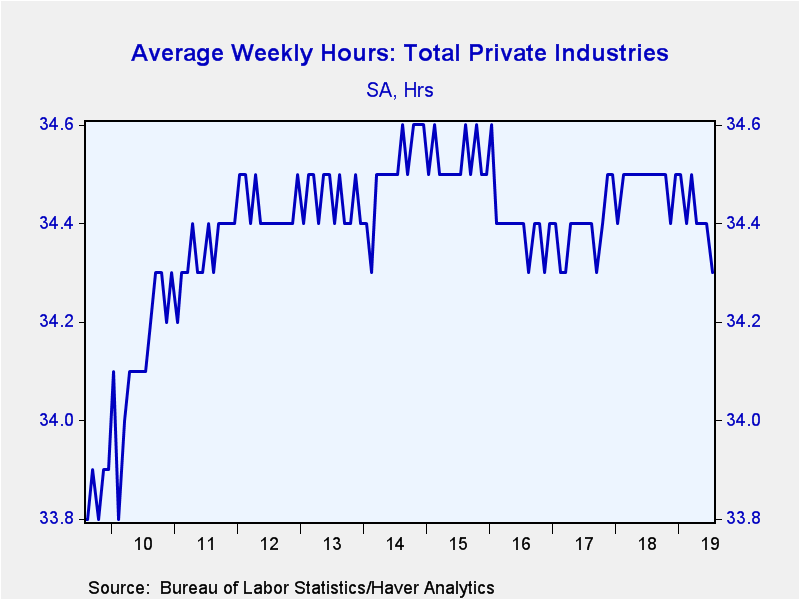 Hours worked per week in the private sector fell to 34.3, the
fewest since September 2017, and below January's 34.5 hour peak. Hours worked in
the mining sector eased to 46.4. Factory sector hours eased to 40.4 and
construction sector hours fell to 39.1. Private service sector hours held steady
at 33.2 but they fell to 36.1 in the information sector. Financial activities
hours of 37.6 compared to a low of 37.1 during all of 2013. Professional
& business services hours have been fairly steady at 36.1 but education
& health sector hours fell m/m to 32.9. They still were longer than the
32.6 level in 2014. Hours worked in the leisure & hospitality sector fell
to a six-year low of 25.8.
Hours worked per week in the private sector fell to 34.3, the
fewest since September 2017, and below January's 34.5 hour peak. Hours worked in
the mining sector eased to 46.4. Factory sector hours eased to 40.4 and
construction sector hours fell to 39.1. Private service sector hours held steady
at 33.2 but they fell to 36.1 in the information sector. Financial activities
hours of 37.6 compared to a low of 37.1 during all of 2013. Professional
& business services hours have been fairly steady at 36.1 but education
& health sector hours fell m/m to 32.9. They still were longer than the
32.6 level in 2014. Hours worked in the leisure & hospitality sector fell
to a six-year low of 25.8.
From the household employment survey, the steady 3.7% unemployment rate reflected mix amongst age groups. The teenage jobless rate rose to 12.8%, and the rate for those aged 20-24 nudged higher to 6.8%. The unemployment rate for individuals between 25 and 54-years-old rose slightly from its 2000 low to 3.1%. The rate for those 55 and over fell to 2.7%.
The labor force participation rate increased slightly to an average 63.0%. For men aged 25-54, it rose to 88.9%, but remained below the 89.5% peak during March. For women aged 25-54, it fell sharply to 75.3%, the lowest level since September 201 8. The employment-to-population ratio edged higher to 60.7%, but it remained well above the 2011 low of 58.2%. The number of people not in the labor force rose 0.3% y/y, well below the peak growth of 2.7% in 2012.
The unemployment rate for individuals without a high school diploma eased to 5.1%. For high school graduates but no college, it slipped to 3.6%. For those without a college degree, it rose to 3.2%. For college graduates, the unemployment rate was 2.2%.
The labor market data are contained in Haver's USECON database. Detailed figures are in the EMPL and LABOR databases. The expectations figures are in the AS1REPNA database.
| Employment: (SA, M/M Change, 000s) | Jul | Jun | May | Jul Y/Y | 2018 | 2017 | 2016 |
|---|---|---|---|---|---|---|---|
| Payroll Employment | 164 | 193 | 62 | 1.5% | 1.7% | 1.6% | 1.8% |
| Previous Estimate | -- | 224 | 72 | -- | -- | -- | -- |
| Manufacturing | 16 | 12 | 2 | 1.2 | 2.0 | 0.7 | 0.1 |
| Construction | 4 | 18 | 1 | 2.7 | 4.6 | 3.6 | 4.1 |
| Private Service-Producing | 133 | 150 | 76 | 1.7 | 1.7 | 1.8 | 2.2 |
| Government | 16 | 14 | -19 | 0.4 | 0.4 | 0.6 | 0.9 |
| Average Weekly Hours - Private Sector | 34.3 | 34.4 | 34.4 | 34.5 | 34.5 | 34.4 | 34.4 |
| Private Sector Average Hourly Earnings (%) | 0.3 | 0.3 | 0.3 | 3.2 | 3.0 | 2.6 | 2.6 |
| Unemployment Rate (%) | 3.7 | 3.7 | 3.6 | 3.9 | 3.9 | 4.4 | 4.9 |
Tom Moeller
AuthorMore in Author Profile »Prior to joining Haver Analytics in 2000, Mr. Moeller worked as the Economist at Chancellor Capital Management from 1985 to 1999. There, he developed comprehensive economic forecasts and interpreted economic data for equity and fixed income portfolio managers. Also at Chancellor, Mr. Moeller worked as an equity analyst and was responsible for researching and rating companies in the economically sensitive automobile and housing industries for investment in Chancellor’s equity portfolio. Prior to joining Chancellor, Mr. Moeller was an Economist at Citibank from 1979 to 1984. He also analyzed pricing behavior in the metals industry for the Council on Wage and Price Stability in Washington, D.C. In 1999, Mr. Moeller received the award for most accurate forecast from the Forecasters' Club of New York. From 1990 to 1992 he was President of the New York Association for Business Economists. Mr. Moeller earned an M.B.A. in Finance from Fordham University, where he graduated in 1987. He holds a Bachelor of Arts in Economics from George Washington University.


